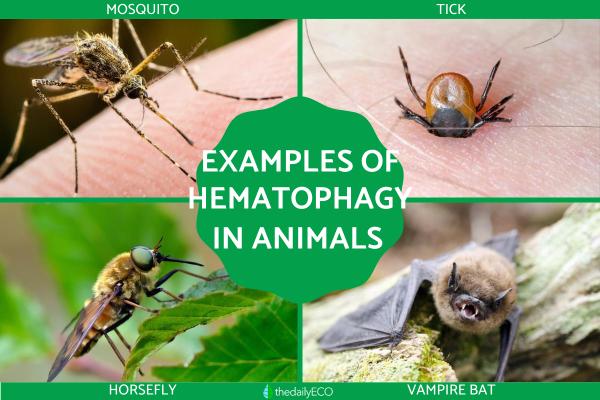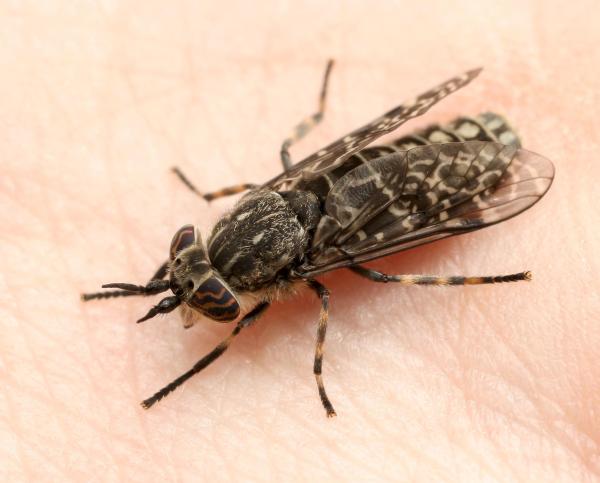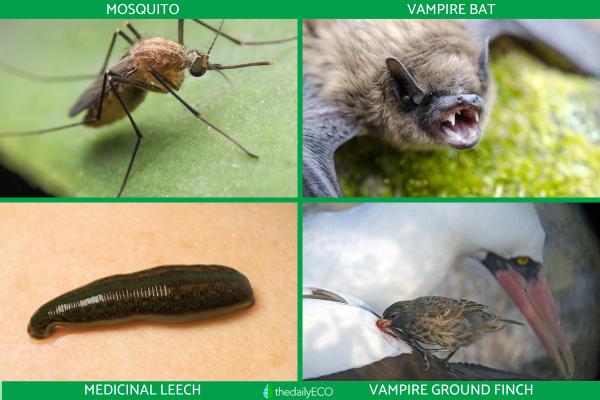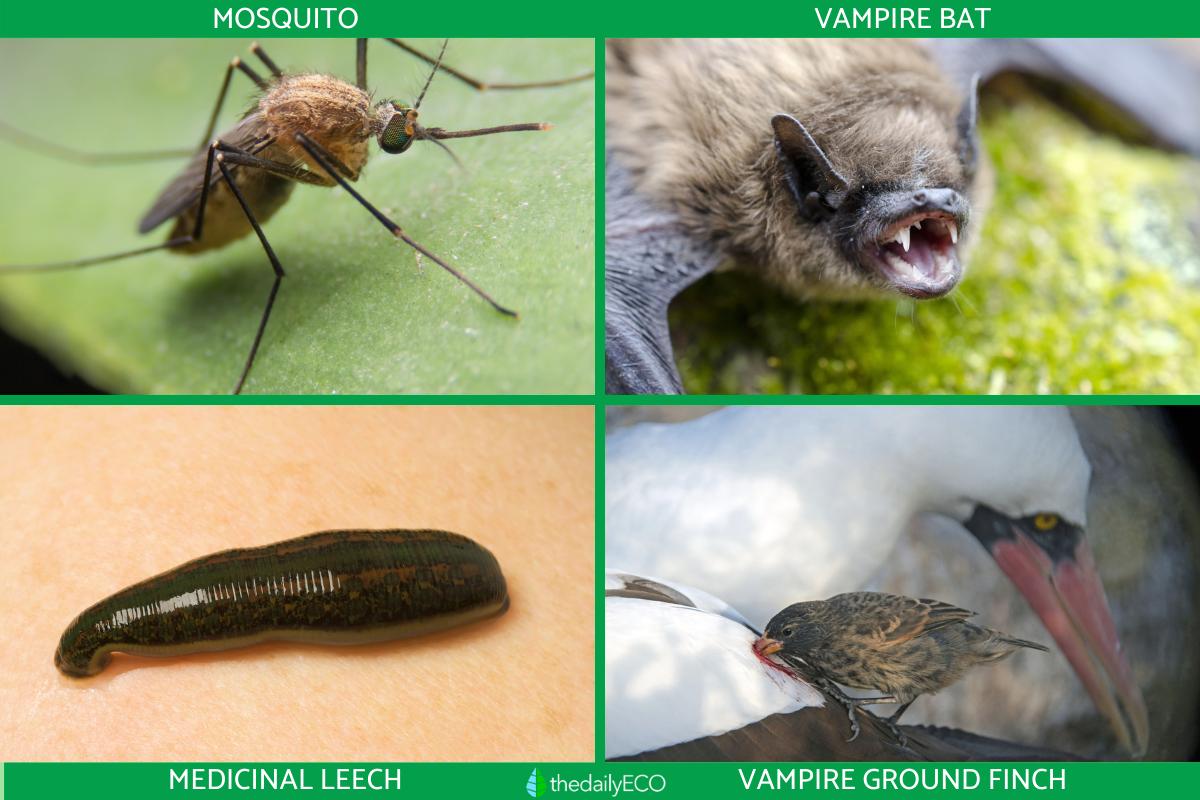Hematophagy in Animals Examples


We may think of blood-sucking animals as the stuff of legends, but there are animals that feed on blood to survive. This process is known a hematophagy and it is likely more common than you think. It is not a method of feeding reserved exclusively for vampire bats, but is found in other mammals, fish, birds and insects. At thedailyECO, we explain a little about what is hematophagy in animals by looking at examples of blood-sucking animals in nature. We provide a little background on some of the most common with photos.
What is hematophagy in animals?
Hematophagous animals are those that feed on blood, so hematophagy is simply the process of feeding on blood to survive. Some They are also known in the medical field as blood-eating animals since they suck the blood directly from the veins of the animals on which they feed.
We can find different blood-sucking animals in relation to different criteria. Some blood-sucking animals are exclusive hematophagous, while others may derive nutrition from other sources. According to their diet we can find:
- Obligatory hematophagy: they are hematophagous that must necessarily feed on blood, without any other type of food and throughout their lives.
- Facultative hematophagy: they combine the consumption of blood with other types of food.
There are also types of hematophagous according to the groups:
- Annelids
- Onsects
- Fish
- Mammals
- Birds
Regarding the location we can distinguish between:
- Ectoparasites: they are outside the body of the organism they parasitize.
- Endoparasites: live inside another organism.
According to the level of association to whom they parasitize there are:
- Permanent: they are the ones who always stay attached to whom they parasitize.
- Mobile: they move from one place to another, reaching different hosts.
Learn more about arthropod behavior with our related article on diapause in insects.

Characteristics of hematophagous animals
In order to sustain this peculiar diet, blood suckers have certain adaptive characteristics. These include the following::
- Bloodsuckers do not kill their prey for blood because doing so would mean that there would no longer be a constant supply of blood.
- They have mouth appendages with which they inflict punctures or openings in the skin. it is through these openings they can suck the liquid.
- Some may inject a local anesthetic so that the prey does not feel like it is being injured to obtain blood.
- These lesions are not poisonous because they are intended to draw blood. However, they can cause itching, bleeding, granulomas, inflammation or diseases caused by the transfer of pathogens through these vectors.
- Blood has the ability to clot to prevent bleeding. This clotted and solidified blood cannot be ingested by hematophagous animals. For this reason, blood-sucking animals have anticoagulant substances in their saliva to be able to suck blood without problem.
- Those animals who have a exhibit obligatory hematophagy have a digestive system adapted to a totally liquid diet. They may have specific enzymes to process blood, bacteria with which they can create symbiosis, or fast-absorbing intestinal ceca.
Learn more about symbiosis in biology with our related article.
Examples of blood-sucking animals
Now we know more about what is hematophagy in animals, we can better understand this process by looking at examples of hematophagy in nature. They include:
Mosquitoes
Not all of us will have come across a vampire bat, but it is likely we will have seen a mosquito. This is because mosquitos are the most common blood-sucking animal. They are also the most dangerous to humans, causing more human deaths each year than any other animal in the world. Anopheles mosquitoes can transmit malaria, while Aedes that bite during the day transmit dengue, chikungunya, Zika, or yellow fever.
Mosquito bites carry blood from an infected individual to a healthy one, carrying the disease from one place to another. Female mosquitoes are the ones that bite because they need high amounts of protein to produce eggs. To detect sources of blood, they perceive the CO2 emanating from the skin, and they make a bite to suck the blood. Learn more with our related article on whether mosquitoes have teeth.
Horseflies
Other blood-sucking insects include horseflies, sometimes known as gadflies. Females have a very strong and sharp mouthpiece that they use to bite vertebrate animals. As with mosquitoes, only the females have this modified mouthpart. In addition to biting and taking a good portion of the skin, they have a porous tissue with which they absorb the blood of the prey. To prevent clotting they have local antithrombotic agents.

Ticks
Ticks are arachnids that use their chelicerae to break the skin to begin sucking blood. They make a kind of hard plug around the bite to hold it strongly. When they are full they drop to the ground.
During the feeding process they can cause Lyme disease, typhus and other nasty diseases which can be caused by feces or saliva. You have to be very careful to remove them correctly and not just rip them off the skin. There is a high probability that parts of the tick remain that generate reactions such as infection and inflammation.
Blood-sucking bats
Despite the fame that bats have gained in popular culture, there are only three species of blood-sucking bats that belong to the family Desmodontinae. They live only in the Americas and have very pointed front teeth. They use infrared light sensors to detect the heat of warm-blooded animals and also use their ears to detect breathing. They latch on to their prey with the help of their teeth to suck the blood.
Vampire bats hunt at night and take advantage of their prey being asleep. In this case, the anticoagulant is called draculin. Learn more about bats with our article looking at different hibernating animals.
Medicinal leech (Hirudo medicinalis)
This is the representative of blood-sucking annelids or ringed worms, but it should be mentioned that not all leeches are blood-sucking. This species has a suction cup which sticks to the prey to slowly suck the blood. They have antithrombins that prevent blood clotting. These leeches have been used in medicine since the ancient Egyptians.
Vampire ground finch (Geospiza septentrionalis)
The last of our hematophagy in animals examples is perhaps an unexpected one. The vampire finch is a peculiar bird that feeds mainly on seeds and insects, but the fresh water in its island habitat is very scarce. It has to supplement it with other sources of vital liquid. These birds tend to peck at other birds, especially boobies, until they draw blood to suck it. In addition to this diet, they supplement with eggs, nopal nectar, bat guano or dead fish abandoned by other predators.

If you want to read similar articles to Hematophagy in Animals Examples, we recommend you visit our Biology category.
- Pagés, T. Blanco, J. & Palacios, L. (2005). Animal Physiology. Barcelona: Editions of the University of Barcelona.
- Keystone, J., Kozarsky, P., Connor, B., Nothdurft, H., Mendelson, M. & Leder, K. (2020) Travel Medicine. Spain: Elsevier.







